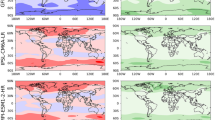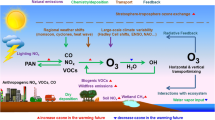Abstract
In this study, comparison of model results and satellite observations reveals that the Whole-Atmosphere Community Climate Model (WACCM-3) reasonably well reproduced the distributions and seasonal variations of ClO and HCl concentrations. In three greenhouse gas emission scenarios (A1B, A2, and B1), the ClO, Cl, ClONO2, and HCl concentrations would gradually decrease with time as emissions of ozone depleting substances (ODS) steadily decrease. The rates of the changes in the ClO, Cl, ClONO2, and HCl concentrations are different in the same emission scenario and the rates of change in the same composition concentration are different for different emission scenarios. The ClO, Cl, and ClONO2 concentrations decrease fastest in scenario A2, next fastest in scenario A1B, and slowest in scenario B1. In contrast, the HCl concentration decreases fastest in scenario B1. The ozone concentration recovers quickly, and is highest in scenario A2. The results show that a rapid decrease in the ClO concentration is an important reason for the accelerated recovery of the ozone layer in scenario A2.
Similar content being viewed by others
References
Farman, J. C., B. G. Gardiner, and J. D. Shanklin, 1985: Large losses of total ozone in Antarctica reveal seasonal ClOx/NOx interaction. Nature, 315, 207–210.
Garcia, R. R., and W. J. Randel, 2008: Acceleration of the Brewer-Dobson circulation due to increases in greenhouse gases. J. Atmos. Sci., 65, 2731–2739, doi: 10.1175/2008JAS2712.1.
Jones, A., J. Urban, D. P. Murtagh, et al., 2011: Analysis of HCl and ClO time series in the upper stratosphere using satellite datasets. Atmos. Chem. Phys., 11, 5321–5333, doi: 10.5194/acp-11-5321-2011.
Jonsson, A. I., J. de Grandpré, V. I. Fomichev, et al., 2004: Doubled CO2-induced cooling in the middle atmosphere: Photochemical analysis of the ozone radiative feedback. J. Geophys. Res., 109, D24103, doi: 10.1029/2004JD005093.
Kinnison, D. E., G. P. Brasseur, S. Walters, et al., 2007: Sensitivity of chemical tracers to meteorological parameters in the MOZART-3 chemical transport model. J. Geophys. Res., 112, D20302, doi: 10.1029/2006JD007879.
Lin, S.-J., 2004: A “Vertically Lagrangian” finite-volume dynamical core for global models. Mon. Wea. Rev., 132, 2293–2307.
Liu Yu, Li Weiliang, and Zhou Xiuji, 1999: Development of the 2-D coupled stratospheric-tropospheric dynamical-radiative-chemical model. Part III: Budget of tropospheric ozone. Acta Meteor. Sinica, 13, 200–211.
Molina, M. J., and F. S. Rowland, 1974: Stratospheric sink for chlorofluoromethanes: Chlorine atomcatalysed destruction of ozone. Nature, 249, 810–812.
Santee, M. L., A. Lambert, W. G. Read, et al., 2008: Validation of the Aura Microwave Limb Sounder ClO measurements. J. Geophy. Res., 113, D15522, doi: 10.1029/2007JD008762.
Sassi, F., R. R. Garcia, B. A. Boville, et al., 2002: On temperature inversions and the mesospheric surf zone. J. Geophys. Res., 107, ACL 8-1-ACL 8–11, doi: 10.1029/2001JD001525.
Wang Zhenya, Li Haiyang, and Zhou Shikang, 2001: Chemical research progress of stratospheric ozone depletion. Chin. Sci. Bull., 46, 619–625. (in Chinese)
WMO (World Meteorological Organization), 1998: Scientific Assessment of Ozone Depletion: 1998. Global Ozone Research Monitoring Project Report No. 44, Geneva, Switzerland, 1–694.
WMO, 2002: Scientific Assessment of Ozone Depletion: 2002. Global Ozone Research Monitoring Project Report No. 47, Geneva, Switzerland, 1–485.
WMO, 2006: Scientific Assessment of Ozone Depletion: 2006. Global Ozone Research Monitoring Project Report No. 50, Geneva, Switzerland, 1–567.
WMO, 2010: Scientific Assessment of Ozone Depletion: 2010. Global Ozone Research Monitoring Project Report No. 52, Geneva, Switzerland, 1–438.
Author information
Authors and Affiliations
Corresponding author
Additional information
Supported by the National (Key) Basic Research and Development (973) Program of China (2011CB428605), National Natural Science Foundation of China (41275045 and U1133603), and Key Project of the Chinese Academy of Meteorological Sciences (2013Z005).
Rights and permissions
About this article
Cite this article
Tang, X., Liu, Y., Wang, W. et al. Changes in stratospheric ClO and HCl concentrations under different greenhouse gas emission scenarios. J Meteorol Res 29, 639–653 (2015). https://doi.org/10.1007/s13351-015-4065-3
Received:
Accepted:
Published:
Issue Date:
DOI: https://doi.org/10.1007/s13351-015-4065-3




